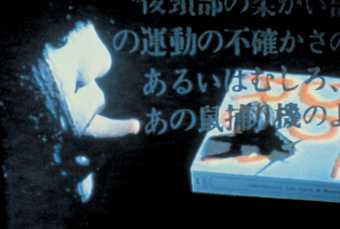āA person receiving letters from an unknown senderā¦ will develop a tense relationship with the āhidden half-worldā where the sender resides.ā
Shūji Terayama, 1976
Terayama was simultaneously a poet writing in traditional form and a prolific horse-racing commentator whose outrageous predictions, based on word associations and literary allusions to the horse's names, parodied the game of predicting winners. Not surprisingly, the rich textual and visual imagery of his film and video work contains remarkably diverse combinations of words and images. In Les Chants de Maldoror, Terayama deconstructs LautrĆ©amontās proto-surrealist book with āa reading filmā in which text from the Japanese translation is embedded within delirious imagery juxtaposing the book itself with glowing nude forms and the interaction of human and animal counterparts. The world of Les Chants is a world of fluid frontiers and free flowing forms.
Grass Labyrinth appropriates the look of pre-modern Japanese sideshows for a cinematic fantasia held together by the refrain of an enigmatic tune; a boy on the cusp of manhood is haunted by a lyric his mother sang to him as a child, only to leave the audience with this riddle unanswered.
In Video Letter Terayama and ShuntarÅ Tanikawa use rudimentary video equipment to compose Renga poetry, an ancient Japanese tradition for the exchange of letters. Terayama and Tanikawa, as senders and receivers, play both parts in this ritual correspondence, which recalls the Letter Drama of TenjÅ Sajiki in which the protagonists were simultaneously actors and audience. The writer, Barbara London has described video letter as āa kind of epitaph or mourning poem for Terayamaā. It was one of his final collaborations, which took place over two years and came to an end with his death in 1983. Renga poetry can be seen as equivalent to the Occidental practice of literary correspondence and in this consumer video variation we can discern a portrait of Terayama that is elegiac against the more familiar image of an explosive enfant terrible.
Les Chants de Maldoror (Marudororu no Uta)
Shūji Terayama, 1977 Japan, 16mm, 27 min
Grass Labyrinth (Kusa-meikyū)
Shūji Terayama, 1983 Japan, 35mm, 40 min
Video Letter
ShÅ«ji Terayama & Tanikawa ShuntarÅ, 1983 Japan, Video, 74 min
Curated by Thomas Dylan Eaton in association with É«æŲ“«Ć½.Ā
With generous support from Daiwa Anglo-Japanese Foundation, Japan Foundation, Sasakawa Foundation, Toshiba Foundation, and All Nippon Airways.Ā
Tate Film is supported by Maja Hoffmann / LUMA Foundation.

